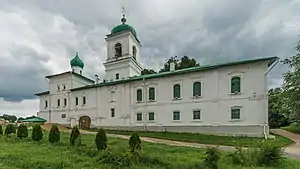Mirozhsky Monastery
Mirozhsky Monastery is a 12th-century Russian Orthodox monastery complex in Pskov, Russia, famous for its frescoes, located in the Christ's Transfiguration Cathedral. The name of the monastery is derived from the name of the Mirozha River, since the monastery is located at the place where the Mirozha joins the Velikaya River, on the left bank of the Velikaya. The catholicon of the monastery is one of the two pre-Mongol buildings which survived in Pskov, and contains the frescoes of the 12th century.


History
The exact date of the founding of the monastery is not known. Traditionally, it is considered to be the mid-12th century and is associated with the name of Nifont, Bishop of Novgorod.
The monastery, located 20 minutes walk from the Pskov Krom (the other name for Kremlin), was one of the cultural centers of the city, comprising library, scriptorium and icon workshop.
Architecture
The ancient buildings, with the exception of the Christ's Transfiguration Cathedral, have not survived. Now the architectural ensemble consists of:
- Christ's Transfiguration Cathedral (12th–beginning of the 20th century)
- Prior’s house (16th—19th centuries)
- St Stephen's Church (17th century)
- Dorter, literally “Fraters’ House” (end of 18th—19th centuries)
- Cells (17th—19th centuries)
- Bathhouse (beginning of the 19th century)
- Outer wall (1799—1805)
References
External links
| Wikimedia Commons has media related to Mirozhsky Monastery, Pskov. |
- "The monastery website" (in Russian). Спасо-Преображенский Мирожский монастырь. Retrieved 25 September 2012.
- photos of the frescoes on Flickr
- photos of the frescoes on Picasa
- Mirozhsky Monastery (Pskov)